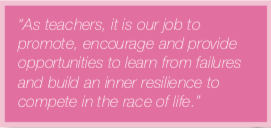Practical Strategies in Building Student Strengths

It is a time of year that elicits a mix of emotions. Everything from anticipation, anxiety, stress and for many students, a burning desire for a promising outcome. Ideally, this event should evoke one to ask themselves questions, such as, “What could I have done?” and, “What could I do next time to improve?” Yes! It is report card time!
As teachers, it is our responsibility to hold students accountable for their own learning. Often this is done by assigning a letter grade. Not only is this letter grade meant to reflect measurable learning, it can potentially serve as a misconstrued symbol for student’s belief, attitude and confidence within themselves as learners. Furthermore, it could represent how they internalise their capabilities, what direction they take when confronted with failure and how they perceive themselves as a reflection of their grades.
This article is not about report cards or grades, but it is about resiliency. By resiliency in the context of learning, I mean how students “bounce back” when they experience failure, as well as the “hurdles“ they encounter and overcome in order to reach success. Additionally, I feel it is safe to say that Habits of Mind plays a significant role in building resilience.
So, how can we develop resiliency and Habits of Mind when setbacks occur with students?
This piece will discuss two instructional strategies on how to build resiliency through Habits of Mind along with some example statements to utilise within the classroom. Remember, what we say and how we use common language in the classroom goes a
long way. In addition, I will offer two “impromptu” strategies for de-escalating frustration while building resiliency with a Habit of Mind.
Instructional Strategy Hurdle #1
Activity: Striving for Accuracy Resiliency Opener
The Plan:
Every class should begin with an opening activity that grabs attention, focus and interest. It can be anything connected to prior knowledge, learning outcome for the day or a simple and exciting activity to stimulate thinking. The big question with any opener should be, “How could the opening activity build resilience through striving for accuracy?” Here are a few examples:
• Brainteaser: A challenging brain teaser offers students opportunity to fail and then recover in a safe environment. Phrase the question in such a way as, “Strive for accuracy in solving this brain teaser with a resilient mindset. If you fail, bounce back and recognize what you did wrong and try again next class. Keep focused and do your best.”
• Story Time: Tell a story about someone who presented resilience. It can be an individual from history, currently in news, sports star, character from a novel, family member or even yourself. Phrase the question in such a way as, “Tell a brief story about someone who exemplified and modeled resilience in their life. How did they strive for accuracy in order to be resilient?”
It is a time of year that elicits a mix of emotions. Everything from anticipation, anxiety, stress and for many students, a burning desire for a promising outcome. Ideally, this event should evoke one to ask themselves questions, such as, “What could I have done?” and, “What could I do next time to improve?” Yes! It is report card time!
As teachers, it is our responsibility to hold students accountable for their own learning. Often this is done by assigning a letter grade. Not only is this letter grade meant to reflect measurable learning, it can potentially serve as a misconstrued symbol for student’s belief, attitude and confidence within themselves as learners. Furthermore, it could represent how they internalise their capabilities, what direction they take when confronted with failure and how they perceive themselves as a reflection of their grades.
This article is not about report cards or grades, but it is about resiliency. By resiliency in the context of learning, I mean how students “bounce back” when they experience failure, as well as the “hurdles“ they encounter and overcome in order to reach success. Additionally, I feel it is safe to say that Habits of Mind plays a significant role in building resilience.
So, how can we develop resiliency and Habits of Mind when setbacks occur with students?
This piece will discuss two instructional strategies on how to build resiliency through Habits of Mind along with some example statements to utilise within the classroom. Remember, what we say and how we use common language in the classroom goes a long way. In addition, I will offer two “impromptu” strategies for de-escalating frustration while building resiliency with a Habit of Mind.
Instructional Strategy Hurdle #1
Activity: Striving for Accuracy Resiliency Opener
The Plan:
Every class should begin with an opening activity that grabs attention, focus and interest. It can be anything connected to prior knowledge, learning outcome for the day or a simple and exciting activity to stimulate thinking. The big question with any opener should be, “How could the opening activity build resilience through striving for accuracy?” Here are a few examples:
• Brainteaser: A challenging brain teaser offers students opportunity to fail and then recover in a safe environment. Phrase the question in such a way as, “Strive for accuracy in solving this brain teaser with a resilient mindset. If you fail, bounce back and recognize what you did wrong and try again next class. Keep focused and do your best.”
• Story Time: Tell a story about someone who presented resilience. It can be an individual from history, currently in news, sports star, character from a novel, family member or even yourself. Phrase the question in such a way as, “Tell a brief story about someone who exemplified and modeled resilience in their life. How did they strive for accuracy in order to be resilient?”
The Connection:
Striving for accuracy plays a significant role in building resilience. When an unsuccessful outcome occurs, it is critical that one re- evaluates the situation to find ways to improve while displaying precision in their steps going forward. A “friendly safe” zone and “friendly common language” offers comfort in practicing resilience.
Instructional Strategy Hurdle #2
Activity: The Metacognitive Resilience Scale
The Plan:
Before any assignment, project or activity that could pose uncertainty or confusion, take some time to gauge students’ confidence. When students receive a test score, project or pre- assessment, get a feel for their capacity to recover. By recognizing how students “feel” via an indicator is critical within in any learning situation. This is students’ practicing Metacognition – being aware of their thoughts, feelings, actions, and strategies. Start by placing a scale at the top of assignment sheets or having an enlarged scale visible in the classroom for students to indicate their level of resilience. Provided below is an example scale and a description of situations where this scale could be utilised within the classroom setting.
• Resilience Predictor: After reviewing an upcoming 10- day detailed project with multiple steps to a class, it is crucial to make sure to stop and ask for clarification. This offers opportunity for students to ask questions, identify particular sections of struggle, brainstorm ideas and develop a game plan for how they will approach this monstrous project. To track students’ resilience along with Metacognition, each day students will reflect on the following:
- Using the resilience scale, where do you rate yourself now? Why?
- How are you using Metacognition through this process?
- A way to phrase this could sound like, “Before we begin ourprojects, it is important to rate your feeling of resilience.
- Think about your rating number, why that number represents your resilience and how practicing Metacognitioncould support your progress in building your resilience?”
The Connection
Metacognition and resiliency go hand-and-hand. When one thinks about their own thinking according to overcoming a setback, the more resilient they become.
Hurdling “Impromptu” Resilience and Habit of Mind Recovery
It is a common experience that occurs across all grade levels and classrooms: frustration. Teachers can often recognise the signs: a defeated sigh, sheepish gaze to floor or a demeaning comment to self. Sometimes it can be more blunt with comments like, “I’ll never be able to do this,” “Forget it. I am done,” and “I’m not smart enough.” All of these are statements that should signal a call for action. As teachers, we need to embrace opportunities where we can turn these signs and statements into building resilient impromptu moments. Below are three ways to develop resiliency when recognising a frustrating situation for students:
- The Risk Taker: Always compliment a student when taking a responsible risk in class. Whether it be answering a question wrong, stumbling on words while reading out loud, or even volunteering to go first for a class presentation.These are opportunities to build confidence, optimism, and risk taking… all while in a safe space.
- Blending Minds: The saying goes, “Two minds are better than one.” When you present a challenging activity or problem, and you recognise frustration building in some students, offer a 3-minute thinking interdependently session. This gives students an opportunity to pair up with a peer and collaborate. It is not about finding the answer, but rather the focus should be on sharing thought processes.
The Final Yet Never Ending Hurdle
No matter what, hurdles will never end. Children will always come across situations in school and in life where the track has no end and challenges always exist.

